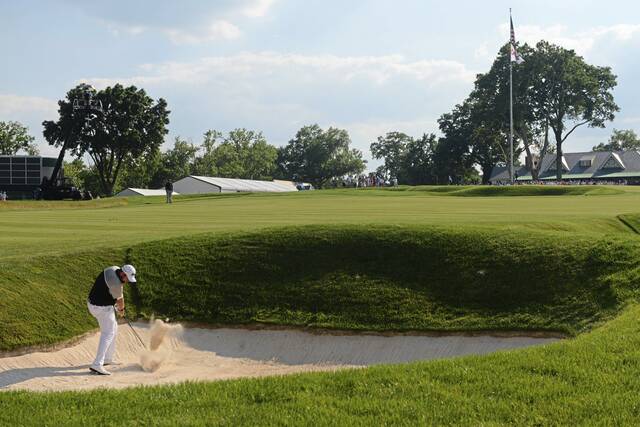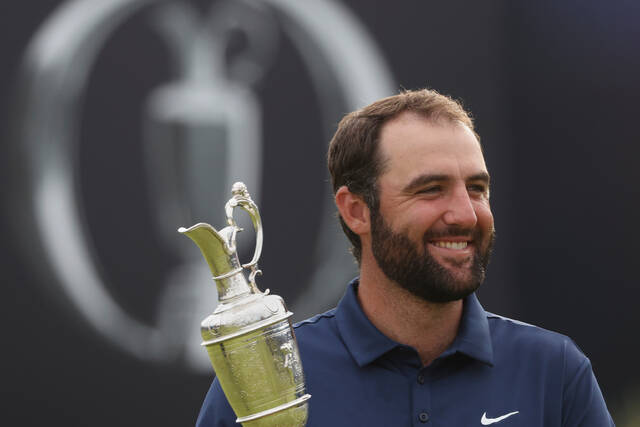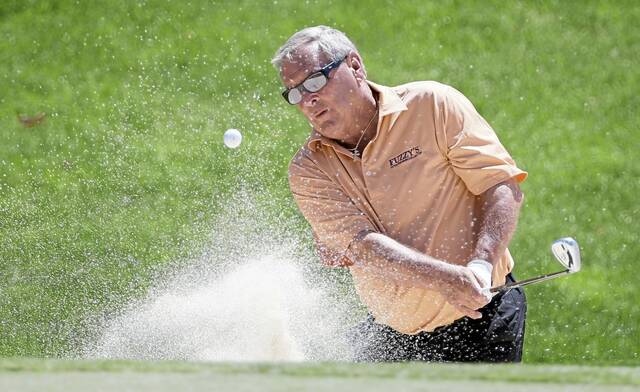Niclas Fasth called home to Sweden after finishing his final round at the 2007 U.S. Open at Oakmont Country Club. It had been a stellar tournament for Fasth, a fourth-place finish that ended up being one of his best career performances in a major.
The call, however, was not celebratory. He wanted to tell his wife he was withdrawing from the following week’s European Tour event.
“I said, ‘I’m going to pull out. I am so tired,’ ” Fasth told TribLive. “ ‘I’ve given everything, and I have nothing left.’ ”
The news was stunning, considering the BMW International Open was one of Fasth’s favorite events.
With the promise of meeting him at the tournament and bringing their children, Fasth’s wife convinced him to play. He ended up winning, mainly because, he said, he was in the midst of one of the best stretches of golf in his career.
Besides, after a week at Oakmont, the BMW International venue must have seemed like a par-3 course.
“There was no letup. There were no easy shots. This often is true for a U.S. Open, of course, but that was the hardest I played,” said Fasth, who played in six U.S. Opens, all at different venues. “It was extreme. You just had to have so much energy and patience to have the strength to try to get up and down one more time.”
It is no secret that the USGA enjoys setting up a challenging course for its national championship. Fast greens, sticky rough and narrow fairways push already-difficult courses to the brink of what some players might consider unfair.
That seemed to be the prevailing thought in 2007. Angel Cabrera’s 5-over-par topped the field, and in the 25 U.S. Opens played since the turn of the millennium, Oakmont 2007 — along with Winged Foot the year before — produced the highest winning score.
The cut was 10-over. There were only eight sub-70 rounds during the week. There were 39 rounds of 80 or higher the first two days alone.
“I was probably one of those complaining,” Sweden’s Peter Hanson joked regarding his experience in 2007. Hanson finished tied for 30th at 17-over. “The rough was brutal. It was a bit of an eye-opener for me to play Oakmont for the first time because it was like nothing I had seen before.
“To be honest, it was borderline. It was almost getting a little bit on the crazy side.”
The numbers just reinforced what many believed: that Oakmont is one of the most difficult courses in the world. India’s Jeev Milkha Singh, a well-traveled veteran who has played in the past two U.S. Opens at Oakmont, called it “a test of golf at the highest level.”
So how does it stack up against other frequently used U.S. Open venues?
There are eight courses that have hosted the men’s U.S. Open at least five times: Oakmont (9), Baltusrol (7), Winged Foot, Pebble Beach and Oakland Hills (6 each) and Shinnecock Hills, Merion and The Olympic Club (5 each). TribLive’s examination of results on the USGA’s website revealed where Oakmont stands:
• The average number of players to finish under par for an Oakmont U.S. Open is 2.9, making it the third “easiest” behind Pebble Beach (7.2) and Baltusrol (3.3). Winged Foot (0.30) and Shinnecock Hills (0.60) had the lowest average number of finishers under par.
• The total aggregate score of the nine U.S. Open winners at Oakmont (4-over) places it in the middle of the pack. Pebble Beach, again, came in as the easiest (six winners, 32-under), and Merion was the toughest (five winners, 14-over).
• Where Oakmont truly bites players is in yielding sub-70 rounds, an average of 16.3 per Open, making it the stingiest by a fraction over Winged Foot (16.5).
“You want a hard golf course,” Paula Creamer told TribLive. Creamer was the only player under par when she won the Women’s Open at Oakmont in 2010. “You don’t want 20-under-par to be winning. But, at the same time, you want it to be fair as well. And fair is such a big, up-in-the-sky word, especially when it comes to golf. You want it ‘playable.’ I think ‘playable’ is probably the correct term.”
Nine years after Cabrera won the war of attrition at Oakmont, the course proved to be more “playable.” Dustin Johnson won with a 4-under. He was one of six players who finished at even par or better, and there were 52 rounds under 70 for the week.
That result falls more in line with other U.S. Opens of recent vintage. The median score of the past 25 winners is in the neighborhood of 4- or 5-under.
One caveat: Hanson, who also played in the 2016 U.S. Open, said Oakmont played differently than in 2007, in large part because of rain that hit the area midweek. That, he said, took a bit of sting out of the course in the early rounds.
But back to Creamer’s point: Larry Nelson, the 1983 U.S. Open winner at Oakmont, said he believes the course is perfectly fair in its setup.
“It’s only unfair if you can’t hit it in the fairway or can’t hit it on the green,” Nelson, who also played in the 1994 Open at Oakmont, told TribLive. “We always knew when we went to the U.S. Open that the fairways are going to be narrower, and the rough was going to be higher and the greens were going to be as firm as they could get them and as fast as they could get them.
“I’ve seen golf courses that I thought were close to being unfair, but I’ve never seen Oakmont that way.”
That might be so, but it’s clear that if course setup and external conditions dovetail just the right way, Oakmont is capable of raising scores and blood pressures. What will it deliver this year?
“If you polled all the players, I think 98% of them are saying it should be one of the hardest tests we face all year,” D.J. Brigman, who finished tied for 30th in 2007, told TribLive. “That’s the expectation. That’s the way it should be. (Oakmont) lives up to that.”
Singh told TribLive: “Most of the time you’re going to get bad breaks and get bad bounces. You feel, ‘I hit a great shot, man, how could it end up there?’ You’ve got to take it in stride. It’s the toughest thing for a golfer to do, but it’s the most important part of playing Oakmont and especially a U.S. Open.”















